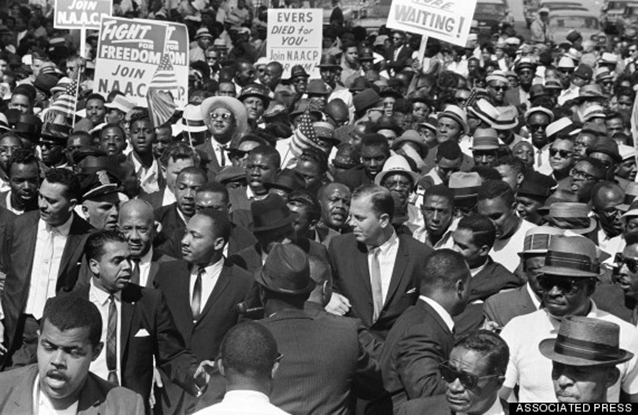by Charles Simmons
January 19, 2015
I remember Detroit’s 1963 Walk to Freedom with Martin Luther King, Jr. I was part of a youth organization, UHURU (meaning “freedom” in Swahili). We had taken this name because throughout the 1950s UHURU had been the battle cry of the people of Kenya struggling against British colonialism.
I had just returned from serving in the U.S. Air Force, where I had experienced the brutal, barbaric and inhumane treatment of African Americans in Mississippi and Georgia. I had begun to oppose the U.S. war in Vietnam and the invasion of Cuba. I was a third-generation factory worker on the line in the auto industry and a first generation student at Wayne State University.
As we young folk marched to Cobo Hall in 1963 for fundamental democratic rights, we carried our own signs and the spirit of self-defense: “Negroes with Guns Will Overcome,” in sympathy with the struggles up north over brutal injustice and hypocrisy, and in the South where the KKK carried out drive-by shootings, lynchings, torture, and burnings of Black churches. Our signs were not allowed, but our spirit remained defiant against U.S. racism and imperialism. We were impatient and felt that the old folks, most people over 30, were going too slow.
 The Detroit Walk to Freedom on June 24, 1963.
The Detroit Walk to Freedom on June 24, 1963.
In this movement, there were fundamental disagreements about tactics, strategy, and vision. But Dr. King was clear in his question: Do we want to integrate into a burning house? As I saw it, he meant the house of capitalism, racism, and oppression locally and globally. Many others more conservative or moderate thought the simple act of racial desegregation was sufficient for success of the movement. That was the group that dominated the struggle and the outcome.
UHURU youth were critical of the establishment civil rights organizations. We supported SNCC, the Black Panther Party, Robert F. Williams, and the Deacons for Self-Defense who fought the KKK in North Carolina and Louisiana. We opposed racism in the trade unions and in the manufacturing industries. We talked about building a new society, but it wasn’t clear exactly what we wanted.
Deep Layers of Justice
There were many small and large victories. This was the beginning of desegregation. There were civil rights bills, a tremendous expansion of the African-American middle class, the massive entry of women into the labor force, and the end of the war in Vietnam. Radical Black youth begin to talk to one another across borders of race and class. But over the 50 years since we’ve seen that the struggle for justice has many layers, some that we addressed in the 1960s and some that we did not.
We opposed the war in Vietnam but didn’t–as MLK had argued we should–fight for a global system of peace and justice.
We never dreamed that half a century later we’d still be fighting against police violence. Nor could we have imagined Detroit forced into bankruptcy.
We didn’t address the fundamental issue of capitalism, which profited from slavery and war, then and now, and stole land and minerals and snatched food from the mouths of the poor locally and globally.
We didn’t address the relationship between Western wealth and deepening poverty in our cities and family farms, and among the masses in the Third World, nor our militaristic foreign policy, and how we in the rich nations–even the workers and middle classes–benefit from the plunder and rape of the peoples of the global South.
We didn’t address the war on Mother Earth through plunder of minerals, pollution of the air and water, and destruction of forests and family-based agriculture.
We didn’t realize that we were challenging a system that is centuries old–rooted in slavery and serfdom–and that we needed long-distance runners to spend their lifetimes engaged in the struggle for justice. We didn’t address the importance of women’s leadership.
Today, we must continue to redefine democracy and human rights. We must think as citizens of the entire planet earth and not just one nation. The old meanings created in the previous centuries are obsolete. Every people and everybody across the planet must have a real voice based on honest information and access. That must include extending power, information, and decision-making to the people at the bottom rather than the top-down process we currently experience. Whatever we fight for locally must also benefit the farmers and workers of the Third World, and cause no harm to the environment. We must build bridges throughout the state at the grassroots level, across political parties and racial/ethnic/faith groups, and recognize youth leadership.
As we confront the current challenges of those who are stealing our democratic rights on all fronts and on all levels, it is useful to remember the words of Abolitionist Mother Harriet Tubman, and the instructions she gave to the enslaved Africans about to escape from torture, rape and pillage of U.S. Democracy:
“When you hear the barking of the dogs chasing you; don’t look back. When you see the lights in the forest moving toward you; don’t stop and don’t look back. Keep Moving! When you hear the shouts of massa calling after you; Keep Moving! Don’t stop and don’t look back; Keep Moving! Cause if you want a taste of Freedom, Keep Moving!”
Charles Simmons, a lifelong activist, delivered this speech at the annual Martin Luther King Day Commemoration, January 21, 2013 at Central Methodist Church in Detroit. It has been slightly edited. Dr. Simmons and his wife, Sandra, have established The Hush House Black World Museum and Leadership Training Institute for Human Rights in Detroit. An emeritus professor of journalism and law at Eastern Michigan University, he is working on an historical autobiography, to be published in mid-2015.
